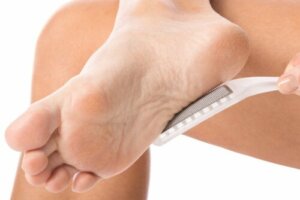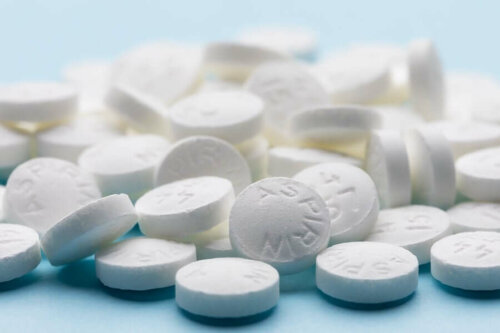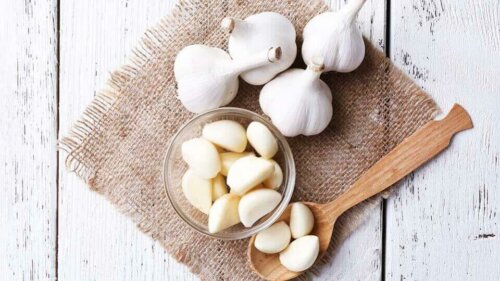How to Remove Calluses Naturally


Written and verified by the doctor Maricela Jiménez López
Currently, there are several alternatives to remove calluses. In fact, several cosmetic products and techniques greatly reduce them. However, others bet on some natural remedies that provide interesting effects. Are you interested in knowing them?
According to information from the American Academy of Dermatology, calluses are hard, thickened areas of the skin that are formed by constant friction against shoes or other elements. Although they’re common on the feet, they also form on the hands and the tips of the fingers.
This same entity highlights that, for the most part, they gradually disappear when the cause is eliminaed. However, if it persists or becomes painful, you need to consult a dermatologist or podiatrist. Milder cases can be improved with some natural preparations.
Do you want to know more? Read: Seven Home Remedies to Remove Foot Calluses
Natural remedies to remove calluses naturally
Many of the natural remedies to remove calluses come from popular culture and aren’t backed by science. However, as they’re mild and for topical use, they’re usually safe to apply. But given the lack of evidence, they’re likely to be ineffective in some cases. Anyway, if you want to try them out, discover some options below.
1. Aspirin and lemon

When you combine both of these ingredients, the result is a paste that softens calluses. This makes them much easier to remove with the help of a pumice stone. In fact, a review published in Clinical, Cosmetic, and Investigational Dermatology recognized that salicylic acid (the active ingredient in aspirin) is a safe and effective exfoliating agent for various dermatological and cosmetic issues.
Ingredients
- 7 aspirins.
- 1 lemon.
Instructions
- In a mortar and pestle, completely crush the aspirin.
- Squeeze the lemon and add its juice while mixing well.
- You can add a little water, if necessary, to make the paste smoother.
- Clean and dry your callus. Then, apply a good amount of this home remedy to it.
- Wrap it in a plastic bag and let the remedy work for 20 minutes.
- Rinse it off with hot water and finally rub the callus gently with a pumice stone.
2. Onion
No studies support the efficacy of onion as a remedy against calluses. However, people apply it because they consider it effective. This would be because it’s believed that its sulfur compounds help to remove dead skin and soften hardness, thus facilitating callus removal.
You only need an onion cut down the middle.
- Rub it all over your callus and cover your affected foot with a sock.
- The next day, rinse it well.
- Repeat this treatment every night for at least a week.
- If you have sensitive skin, be careful with this remedy, as it may cause irritation.
3. Chamomile tea

As chamomile tea has proven anti-inflammatory properties, it’s considered that it can help softening calluses and facilitate their removal. To take advantage of it, all you have to do is prepare chamomile tea and, once it’s at room temperature, pour it into a container and submerge your feet in it.
Note: Instead of tea, you could also use chamomile oil.
4. Pumice stone
If you have a tendency to form calluses on your feet, we recommend that you always have a pumice stone on hand. You can buy this in several stores. In fact, it’s one of the options the Mayo Clinic recommends to fight this problem.
This is a special kind of limestone that helps you to get rid of hard spots. Moreover, it can be used both wet and dry.
- Before rubbing with a pumice stone, wash the area around the callus with a neutral soap.
- The exfoliation movements need to be smooth and circular. This way, you won’t hurt your healthy skin.
- It’s a good idea to have a pumice stone in your bathroom and use it when you take a bath.
5. Garlic juice

Garlic is another natural element that people use to remove calluses. In this case, we combine it with olive oil to make a moisturizing product.
Ingredients
- 1 garlic clove
- 2 tablespoons of olive oil (32 g)
Instructions
- Cut the garlic down the middle and crush it.
- Apply the olive oil and mix until you get a paste.
- Apply it to your callus and wrap it with a cloth or plastic.
- Cover your affected foot with a sock.
- Let the remedy work all night long.
- In the morning, rinse it off with warm water.
- Repeat this every day for a week.
6. Tomato
This fruit has many properties that make your skin health better. Topically, it can help moisturize dry skin and help reduce calluses.
- You only need a tomato that you should chop and crush to make a paste.
- Apply this paste to your callus and bandage it with a cloth.
- Let it work all night long.
- Rinse it off in the morning.
- You should repeat this treatment over the course of a week.
Visit this article: How to Grow Tomatoes with just Four Slices of Tomatoes
Did you go see a podiatrist?
Calluses are benign but unsightly problems that you can treat with natural remedies. However, such preparations aren’t backed by science and may be ineffective. But as they’re safe, it doesn’t hurt to try them out.
For more effective ways to eliminate this problem, consult your dermatologist or podiatrist. Without a doubt, they’ll tell you many other alternatives.
All cited sources were thoroughly reviewed by our team to ensure their quality, reliability, currency, and validity. The bibliography of this article was considered reliable and of academic or scientific accuracy.
- Hashmi F, Nester CJ, Wright CR, Lam S. The evaluation of three treatments for plantar callus: a three-armed randomised, comparative trial using biophysical outcome measures. Trials. 2016;17(1):251. Published 2016 May 17. doi:10.1186/s13063-016-1377-2
- Singh D, Bentley G, Trevino SG. Callosities, corns, and calluses. BMJ. 1996;312(7043):1403–1406. doi:10.1136/bmj.312.7043.1403a
- Akdemir, O., Bilkay, U., Tiftikcioglu, Y. O., Ozek, C., Yan, H., Zhang, F., & Akin, Y. (2011). New alternative in treatment of callus. Journal of Dermatology. https://doi.org/10.1111/j.1346-8138.2010.00978.x
- Arif T. Salicylic acid as a peeling agent: a comprehensive review. Clin Cosmet Investig Dermatol. 2015;8:455–461. Published 2015 Aug 26. doi:10.2147/CCID.S84765
This text is provided for informational purposes only and does not replace consultation with a professional. If in doubt, consult your specialist.








